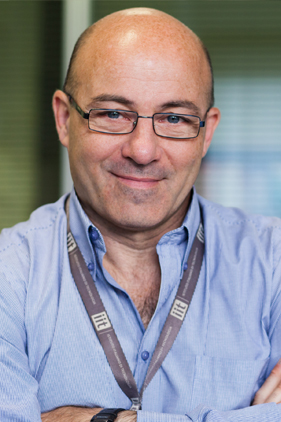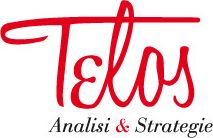August 2016, Year VIII, no. 8
Roberto Cingolani
The dream man
“A scientist is someone who expresses an opinion, answers questions and shapes the future. This means we have to start appreciating that the political-social role of a scientist is very important.”
Telos: You are the Scientific Director of the Italian Institute of Technology. Please tell what you do at the Institute.
Roberto Cingolani: The Scientific Director is institutionally responsible for implementing the strategies and operative management of the Institute. The job involves drafting the scientific plan, coordinating our scientific and administrative activities, and implementing the resolutions of the Executive Committee. In a nutshell, as director I have to manage a complex institute that employs a total of 1470 researchers whose average age is 34. Forty percent of those researchers are foreigners from 56 different countries. Managing the IIT means being a ‘techie’ (i.e., choosing what to research so that we’re globally competitive) and a manager; it includes the institute’s economic management, dealing with the scientific staff and all our employees’ problems. This requires good people skills and extensive knowledge of the different cultures that every day live and work, side by side, at IIT. A complex, rapidly expanding machine like IIT can only function successfully if all the individual parts are in working order. Like the rest of the IIT staff, the Scientific Director is subject to an annual assessment. In my case, I’m carefully evaluated by the Board and the Scientific and Technical Committee.
Let’s take a step backwards. What is the Italian Institute of Technology and which are your pet programmes?
IIT is a State research institute legally established in 2003 and operational since 2006. The start-up phase began that year and ended in 2009. Its objective is to promote excellence in basic and applied research and also the development of the national economy. IIT is funded by the State, industrial agreements and competitive national and international programmes; approximately 20% of the Institute’s overall budget comes from foreign funds obtained through our intense fundraising activities. IIT boasts over 7000 publications, approximately 350 patent applications, 13 established startups and as many currently being launched. The IIT network includes 11 research centres in Italy (Turin, Trento, Parma, Rome, Naples, Lecce, Ferrara, two in Milan and two in Pisa) and two outstations located abroad (MIT and Harvard in the US). The IIT governance model differs from most of the other research institutes. Our model allows us to compete worldwide with the best research institutes. We are currently developing numerous national and international programmes: in the first 6 months of this year we’ve launched roughly 30, over and above the ones already underway and the ones being completed. It’s difficult to say which are my favourites. I’m a nanotechnologist and naturally the ones involving my field of expertise are the ones I feel closest to, for example the programmes focusing on graphene and other two-dimensional materials which not only led to outstanding scientific results, but also to the creation of a new company (BeDimensional) and important agreements with the manufacturing world. Another would be the precision medicine programmes where we study the production of nanoparticles capable of introducing patient-specific drugs into our bodies, but only when required; these drugs are more effective and have fewer side effects. Lately robotics has progressed in leaps and bounds, for example the new R1, the first humanoid made entirely in Italy and produced for the global market, or the Robot Rehab programme which will soon trigger another start-up dedicated to the welfare of older citizens, a group that is growing quickly given our rapidly-ageing planet.
The language of science: research for the few and dissemination for the multitudes. Is this a challenge for ITT too?
First and foremost scientists should stop being only scientists, someone who comes out of a library and into a lab, because up to now this has been really damaging for the international scientific community. A scientist is someone who expresses an opinion, answers questions and shapes the future. This means we have to start appreciating that the political-social role of a scientist is very important. That said, we try as best we can to communicate what it is we’re doing in our research centres in Italy and abroad. Yes, I think this is indeed a challenge, but it is also our duty... to share our research with all those people - the majority - who have no scientific background, because when people pay their taxes they are inputting into our research. It’s only right for them to be able to see and understand the results of our research. We try to produce truly useful technologies, but without loosing sight of the basic knowledge that is often the spark triggering important inventions for the human race. For example, our iClub robotic puppy is a research platform we use to study not only robotics, but also neuroscience and the fundamentals of cognitive psychology. Based on the research we performed on this robot we were able to develop R1, the new humanoid which in roughly two years will be on the market; that research also helped to increase our basic knowledge in several disciplines, from engineering to neuroscience. To interest people in these complex and sometimes sensitive topics we try to participate in events and programmes for the general public. Even if we don’t talk about science in the narrow sense of the word, we inform non-specialists about the most important contemporary scientific topics and perhaps encourage a few young people to embark on a scientific career. I’ll give you a practical example: thanks to our participation in the TV programme Italia’s Got Talent, our robotics was seen by millions of people. After the programme many people contacted us and asked to visit our headquarters - proof that interest in science is very much alive in Italy, even if scientific issues are not the media’s most popular topic. But maybe a new wind is blowing...
Everything in Italy sparks debate. For example, the battle raging over the scientific centre, Human Technopole, to be created on the Expo site. What role will the IIT play, if indeed a role does exist?
As in the past, we are performing, to the best of our ability, what the State has asked us to do. We have offered our skills and expertise free of charge in order to create a project that can give added value to the sistema Italia. Human Technopole could be one of the infrastructures currently lacking in Italy. These infrastructures are not only the engine behind Italy’s international revival, but also a way to stop the brain drain in one of the key sectors of learning and knowledge.
Editorial
Is Italy capable of producing only fashion, designer products and, obviously, agri-foodstuffs? Can the Italian economy progress and evolve only thanks to tourism (Italy’s crude oil????) and our undeniably huge heritage of art and history? Clichés like these are very difficult to dispel. In January 2015 the current Minister of Economic Development, Carlo Calenda, tried to do just that. Participating in the World Economic Forum in Davos, he presented a video entitled Italy the Extraordinary Commonplace (yes commonplace instead of cliché!) to try and confute Italian stereotypes by illustrating our often underrated technological excellence. Stereotypes exist about all nations on earth (but there are more about Italy because we are an ancient and imaginative nation). It’s no use snivelling and denying they exist: to disprove them, facts and behaviour are the way to go. And facts are exactly what the Scientific Director of the Italian Institute of Technology in Genoa, Roberto Cingolani, talks about in this interview. To tell the truth, his job description doesn’t reflect the mandate of a Scientific Director; it’s more like that of a managing director (he plans, organises, manages people and things, and is assessed). An Institute with 1470 researchers whose average age is 34. Forty percent of those researchers are foreigners from 56 different countries. The Institute boasts over 7000 publications, approximately 350 patent applications, 13 established startups and as many currently being launched. If you’re interested in all the rest and what they do, just take a few minutes and read Cingolani’s interview. The IIT is a research and design centre of excellence acknowledged by the international scientific community: it also represents one of the main centres behind the innovation created and developed in Italy, not only by stopping the brain drain, but by attracting foreigners from abroad. The Institute focuses on human-oriented technologies and adopts a transversal approach involving nanotechnologies, life sciences, robotics and cognitive sciences. However, Cingolani doesn’t want IIT products to remain in the lab, he wants them to become consumer objects, life companions, especially the end products of their studies on robotics, designed to help society manage the daily needs of an average lifespan which will very soon reach the 100 year mark.
I would be amiss if I didn’t mention the iClub, the robotic puppy capable of learning and smiling like a child. Thanks to Cingolani’s enlightened concept of a science that should involve human beings, the puppy participated in Italia’s Got Talent. In actual fact the puppy is just an artificial platform, but it joked with the comedian Claudio Bisio about a certain feature they have in common (they are both bold!) and enchanted the public with its ability to do sums in its head and move like a ten-year old child. Scientific progress is possible only if our minds can imagine what still doesn’t exist, or hasn’t been discovered. One of Cingolani’s most obvious traits is his imagination.
The title of this interview is ‘The dream man’. You’re free to interpret it any way you like.

Roberto Cingolani is the Scientific Director of the Italian Institute of Technology in Genoa. He graduated in Physics at Bari University in 1985 and in 1988 obtained his PhD in Physics. In 1989 he was awarded his postgraduate diploma in Physics at the Scuola Normale Superiore (Pisa). Between 1989 and 1991 he worked as a researcher at the Max Planck Institut für Festkörperforschung in Stuttgart. In 1992 he was named Associate Professor of Physics at the University of Salento where in 2000 he became Professor of General Physics at the Faculty of Engineering. In 1997 he was a Visiting Professor at the Institute of Industrial Sciences (Tokyo University) and then at Virginia Commonwealth University (USA). In 2001 he founded and became director of the National Nanotechnology Laboratory (NNL) of the INFM at the University of Salento. Cingolani is the author and co-author of roughly 750 publications (Index H = 76, over 23,000 citations) including articles in international magazines and participation in conferences and books. He holds 46 patent families. He has occupied several national and international institutional posts. This is a list of just a few of his awards: 2 prizes for young researchers assigned by the Società Italiana di Fisica; the “Ugo Campisano” prize assigned by the INFM for studies in the field of the Physics of Semiconductors; the “ST-Microelectronics” prize assigned by the Società Italiana di Fisica; the “Grande Ippocrate” prize for scientific dissemination; and the Italian Gentile di Fabriano prize. In 2014 Cingolani published “Il mondo è piccolo come un’arancia” as a way to make science easy for everyone to understand. In 2015 he wrote the book “Umani e umanoidi” published by Il Mulino.
Milanese, aged 55, Commendatore della Repubblica, his love of science was noticeable even as a child when he won several prizes. Proof lies in the photographs religiously guarded by his mother. However, as a young man he had other interests: diving, boxing and comics - he’s a good freehand draughtsman and has worked as a comic artist. His mad, desperate years of scientific research at the Max Planck Institute sometimes involved sleeping all night in the lab just to further his research. Instead the time he spent in Japan sparked his fascination for that country and his love of raw fish, especially sashimi. A passion he has transmitted to his children.







SocialTelos